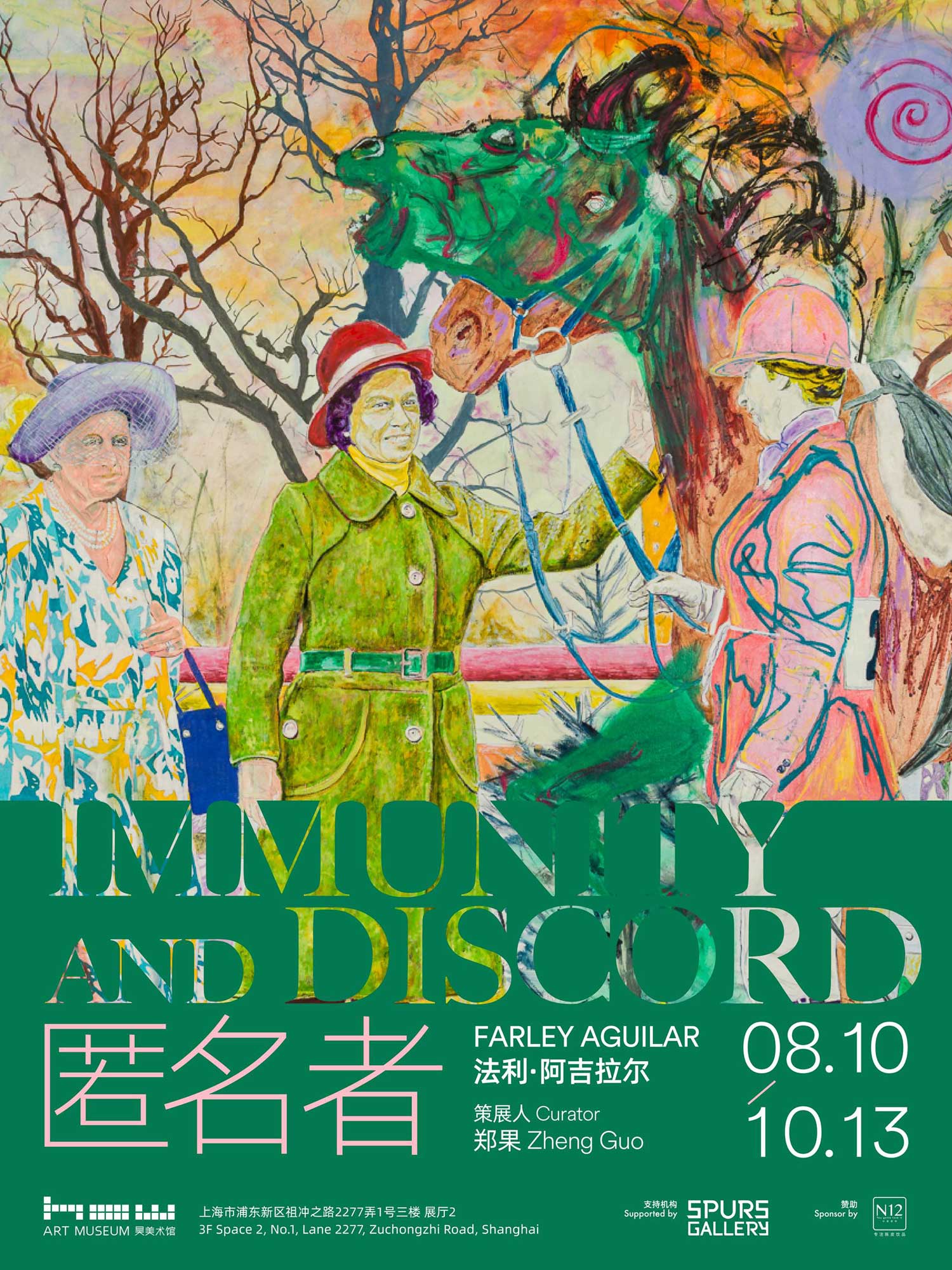展期 Period:
2024.8.10—2024.10.13
艺术家 Artist:
法利·阿吉拉尔 Farley Aguilar策展人 Curator:
支持 Support:
马刺画廊 Spurs Gallery
地点 Venue:
前言 Foreword:
艺术家法利·阿吉拉尔的创作有着基于相同议题在不同视角下的体现与思考的转换。个展 “纸老虎” (Sauvage Effete) 聚焦西方统治阶级与生活在爱德华时代的上流人士;随后其个展 “皮毛与洪水” (Fur and Flood) 将奢华财富的具象体现——皮毛,与象征不可控外部灾害的洪水作为主题,关注到在英国第一次工业革命后囿于生存的人们;而本次艺术家阿吉拉尔在昊美术馆的全新个展 “匿名者”,综合呈现了西方不同阶级人们的生活状态。阿吉拉尔通过休闲方式考察个体与群体的关联,以画作为搭建过去与现在的桥梁,引发对于肤色、种族、性别与社会平衡等议题的思考,从而发掘人类的共性。
阿吉拉尔早年为躲避家乡战乱随家人移居美国,基于自身动荡的经历,艺术家对社会人文议题有着极高的关注度与敏感度。而后文学与哲学的背景又赋予了他对于事件超脱旁人的深入思考与工作方式。阿吉拉尔以英国历史上的爱德华时期(1901-1910年)为调研背景,选取了一系列历史照片。阿吉拉尔对此解释道:“…我之所以使用爱德华时代的图像是因为,在世纪之交大英帝国存在着种种不平等。” 在爱德华时期,巨大悬殊的财富差距是导致当时社会不稳定的重要原因之一。艺术家选择以该时期的历史照片为参照,通过对于不同阶层人物的观察与刻画,来体现人物命运之反差。
阿吉拉尔画中的人物往往是通过身份与场景去定位的“匿名者”,但同时也是真实存在过的芸芸众生。他将影像以绘画的方式呈现,通过转换媒介强调人物外观与所处环境,以具象的细节来体现人物身份。在他的画面中,面孔与肢体反而是被扭曲或以略显滑稽、怪异的处理方式来呈现的。阿吉拉尔也不拘泥于形式,迷幻的色彩由颜料、蜡笔、铅笔甚至石墨组成,而多层次的质感也为引用自现实影像的画作带来了一丝超现实的意味。在作品《六个孩子和风暴中》,人物服装与面部略显突兀的粗糙笔触,和其中一位几乎透明消失的孩童,都在某种程度上跳脱了历史时刻。画面里所产生的无力感正是艺术家在回溯过往后对于当下的思考。
阿吉拉尔试图在画面中,呈现一种被抛掷感。哲学家马丁·海德格尔曾在《存在与时间》中提出,人是被抛入世界、能力有限且处于生死之间。而后哲学家彼得·斯洛特戴克在著作《球体》三部曲里将这种被抛掷状态形容成降生于球体之中(sein-in-den-Sphären),而球体作为免疫(Immunität)外部伤害的结构,将生命体保护在舒适的内部。艺术家深受斯洛特戴克的影响,且思考到人类的降生,无论对于何种阶级来说都要面对必然的风险,阿吉拉尔的创作并非用批判的视角给出结论,而是呈现了时代洪流中,不同人群会面临的问题,从而引发观者对于社会平衡发展的重视。
Artist Farley Aguilar's work features a transformation based on the reflection and consideration of the same issues from different perspectives. His solo exhibition Sauvage Effete focused on the Western ruling class and the upper-class individuals living during the Edwardian era. Following this, his solo exhibition Fur and Flood used the themes of fur, representing luxurious wealth, and flood, symbolizing uncontrollable external disasters, to highlight the lives of people struggling to survive after the first Industrial Revolution in Britain. In his new solo exhibition Immunity and Discord at the HOW Art Museum, Aguilar comprehensively presents the living conditions of people from different Western social classes. Aguilar examines the relationship between individuals and communities through the lens of leisure activities, using paintings to bridge the past and present and provoke thoughts on issues such as skin color, race, gender, and social balance, so as to explore human commonality.
Early in his life, Aguilar fled with his family to the United States to escape the war in his homeland. This turbulent experience fostered a heightened sensitivity and deep concern for social and humanistic issues. His background in literature and philosophy also endowed him with exceptional insights and unique working methods for addressing social phenomena. Using the Edwardian era in British history (1901-1910) as the background for his research, Aguilar selected a series of historical photographs. Aguilar explains, "I use Edwardian images because of the inequalities that existed in the British Empire at the turn of the century." During the Edwardian era, the huge disparity in wealth was one of the major causes of social instability. The artist chose historical photographs from this period as references for observation and portrayal of individuals from different social classes to reflect their contrasting fates.
In Aguilar's paintings, characters are often anonymous individuals identified by their roles and settings, but at the same time, they are also real people who once existed. He presents photos as paintings, emphasizing the appearance of the figures and the environment by transforming the medium, using concrete details to reflect the identity of the individuals. In his work, faces and figures are often distorted or rendered in a slightly comical and bizarre manner. Aguilar's work is not constrained to any specific medium; instead, his psychedelic palette is composed of paint, crayon, pencils, and even graphite, creating a multi-layered texture that adds a surreal touch to the paintings derived from photography. In the piece Six Children with Storm, the slightly jarring rough brushstrokes of the characters' clothing and faces, and the nearly transparent, disappearing child all transcend historical moments to some extent. The sense of powerlessness in the work reflects the artist's view on the present after revisiting the past.
Aguilar attempts to present a sense of thrownness into the world in his paintings. Philosopher Martin Heidegger, in Being and Time, proposed that humans are thrown into the world, with limited abilities and positioned between life and death. Later, philosopher Peter Sloterdijk, in his Spheres trilogy, described thrownness as being born in a sphere (sein-in-den-Sphären), where the sphere, as a structure of immunity (Immunität) from external harm, protects living beings within a comfortable interior. Aguilar is deeply influenced by Sloterdijk and considers that regardless of the social class, humans face inevitable threats upon birth. Aguilar's creative endeavors do not propose conclusions from a critical perspective but instead present the issues different communities face in the tide of the times, thereby drawing the viewer's attention to the topic of balanced societal development.

